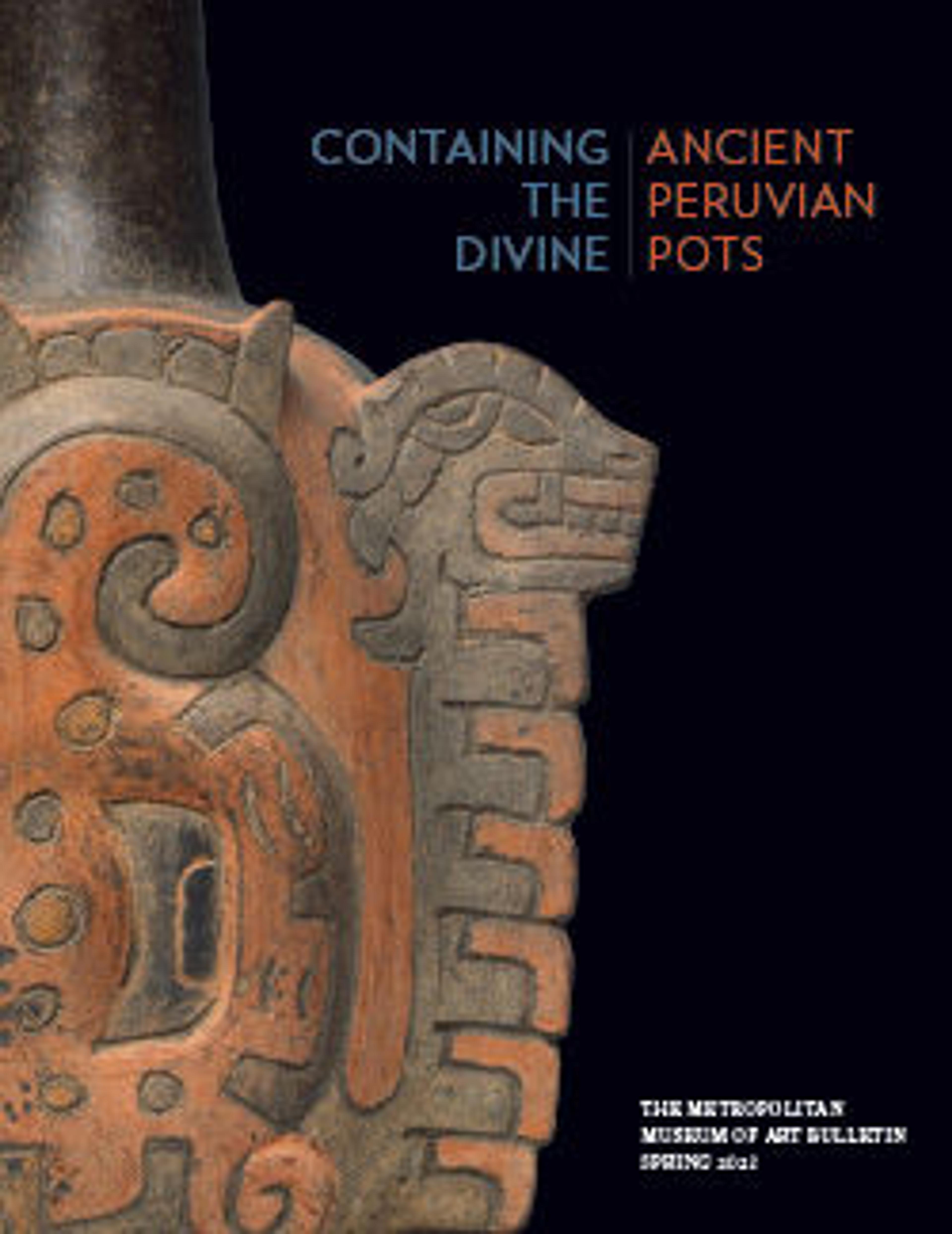Stirrup-spout bottle
Around 1200 BCE, a religious tradition, known today as Cupisnique or Chavín, started influencing the visual arts of the North Coast and highlands of Peru. While some works combined features of felines, raptorial birds, and reptiles, others were non-figurative or more abstracted. Aspects of this striking style, such as the stirrup-spout—a form itself adopted from even earlier traditions of Ecuador—would endure for centuries, ending only in the sixteenth century with the Spanish occupation.
Cupisnique artists preferred a muted palette, usually the color of the fired clay itself, but they created visual interest by contrasting smooth and textured surfaces. On this stirrup-spout bottle, the unornamented sections were created by carefully smoothing the clay when leather-hard, and then burnishing it with a polishing stone (for an example of a polishing stone, see MMA accession number 1994.35.769). The textured areas were produced by adding appliqués and impressing a comb-like tool into the clay. The combination of smooth and textured areas is a visual and tactile reminder of the interior and exterior surfaces of Spondylus shells, a bivalve considered to be among the most precious ritual materials in the ancient Andes (see MMA 2003.169).
Hugo C. Ikehara-Tsukayama, Andrew W. Mellon Curatorial/Collection Specialist Fellow, Arts of the Ancient Americas, 2022
Further Reading
Burger, Richard L. Chavin and the Origins of Andean Civilization. London: Thames and Hudson, 1992, pp. 90-99.
Burtenshaw-Zumstein, Julia T. Cupisnique, Tembladera, Chongoyape, Chavín? A Typology of Ceramic Styles from Formative Period Northern Peru, 1800-200 BC. Unpublished PhD dissertation. Norwich: University of East Anglia, 2014.
Elera, Carlos. "El complejo cultural Cupisnique: Antecedentes y desarrollo de su Ideología religiosa." Senri Ethnological Studies, No. 37 (1993), pp. 229-57.
Cupisnique artists preferred a muted palette, usually the color of the fired clay itself, but they created visual interest by contrasting smooth and textured surfaces. On this stirrup-spout bottle, the unornamented sections were created by carefully smoothing the clay when leather-hard, and then burnishing it with a polishing stone (for an example of a polishing stone, see MMA accession number 1994.35.769). The textured areas were produced by adding appliqués and impressing a comb-like tool into the clay. The combination of smooth and textured areas is a visual and tactile reminder of the interior and exterior surfaces of Spondylus shells, a bivalve considered to be among the most precious ritual materials in the ancient Andes (see MMA 2003.169).
Hugo C. Ikehara-Tsukayama, Andrew W. Mellon Curatorial/Collection Specialist Fellow, Arts of the Ancient Americas, 2022
Further Reading
Burger, Richard L. Chavin and the Origins of Andean Civilization. London: Thames and Hudson, 1992, pp. 90-99.
Burtenshaw-Zumstein, Julia T. Cupisnique, Tembladera, Chongoyape, Chavín? A Typology of Ceramic Styles from Formative Period Northern Peru, 1800-200 BC. Unpublished PhD dissertation. Norwich: University of East Anglia, 2014.
Elera, Carlos. "El complejo cultural Cupisnique: Antecedentes y desarrollo de su Ideología religiosa." Senri Ethnological Studies, No. 37 (1993), pp. 229-57.
Artwork Details
- Title: Stirrup-spout bottle
- Artist: Cupisnique artist(s)
- Date: 800–500 BCE
- Geography: Peru, North Coast
- Culture: Cupisnique
- Medium: Ceramic
- Dimensions: H. 9 5/8 × W. 5 1/2 × D. 5 1/2 in. (24.4 × 14 × 14 cm)
- Classification: Ceramics-Containers
- Credit Line: The Michael C. Rockefeller Memorial Collection, Gift of Nelson A. Rockefeller, 1969
- Object Number: 1978.412.40
- Curatorial Department: The Michael C. Rockefeller Wing
More Artwork
Research Resources
The Met provides unparalleled resources for research and welcomes an international community of students and scholars. The Met's Open Access API is where creators and researchers can connect to the The Met collection. Open Access data and public domain images are available for unrestricted commercial and noncommercial use without permission or fee.
To request images under copyright and other restrictions, please use this Image Request form.
Feedback
We continue to research and examine historical and cultural context for objects in The Met collection. If you have comments or questions about this object record, please contact us using the form below. The Museum looks forward to receiving your comments.
